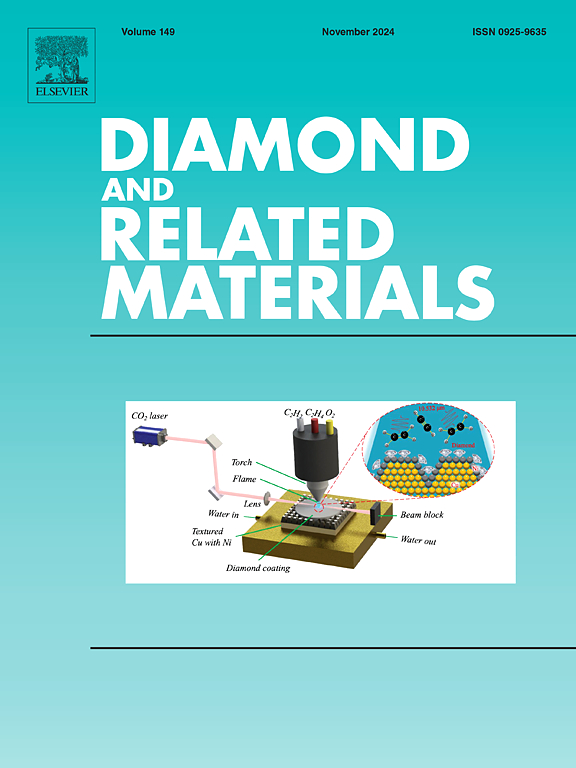新型 N 掺杂氧化锌和 O 掺杂 g-C₃N₄ 异质结:增强抗坏血酸的光催化降解和稳健的电化学生物传感
IF 4.3
3区 材料科学
Q2 MATERIALS SCIENCE, COATINGS & FILMS
引用次数: 0
摘要
众所周知,氧化锌和 g-C₃N₄ 具有光催化降解和电化学应用的潜力,但它们有限的带隙和导电性阻碍了其性能的发挥。掺杂是改变这些特性的一种策略。本研究采用原位水热法合成了掺氮 ZnO(N-ZnO)和掺氧 g-C₃N₄(OCN)纳米复合材料。结构和成分分析证实了合成的成功,而 FESEM 和 HRTEM 则揭示了装饰 OCN 薄片的 N-ZnO 纳米棒。光学分析表明,该材料的带隙为 2.54 eV,在可见光下非常活跃。在 Z 型异质结的促进下,纳米复合材料在 20 分钟内对亚甲蓝(MB)的光降解率达到 90%,速率常数很高(k = 0.1269 min-1)。催化剂在 5 个循环后仍保持稳定。此外,抗坏血酸(AA)的电化学生物传感显示出 0.9965 的回归值,阳极电流响应高,检测限(LOD)值小,这凸显了纳米复合材料在光催化和诊断领域的商业应用潜力。本文章由计算机程序翻译,如有差异,请以英文原文为准。

Novel N-doped ZnO and O-doped g-C₃N₄ heterojunction: Enhanced photocatalytic degradation and robust electrochemical biosensing of ascorbic acid
ZnO and g-C₃N₄ are known for their potential in photocatalytic degradation and electrochemical applications, but their limited band gaps and electrical conductivity hinders performance. Doping is a strategy to modify these properties. This study reports the synthesis of nitrogen-doped ZnO (N-ZnO) and oxygen-doped g-C₃N₄ (OCN) nanocomposites using an in-situ hydrothermal process. Structural and compositional analysis confirmed successful synthesis, while FESEM and HRTEM revealed N-ZnO nanorods decorating OCN sheets. Optical analysis indicated a band gap of 2.54 eV, making the material active under visible light. The nanocomposites demonstrated 90 % photodegradation of methylene blue (MB) within 20 min, with a high rate constant (k = 0.1269 min−1), facilitated by a Z-scheme heterojunction. The catalyst remained stable even after 5 cycles. Moreover, electrochemical biosensing of ascorbic acid (AA) showed a regression value of 0.9965 with high anodic current response and small limit of detection (LOD) value, underscoring the potential of nanocomposite material for commercial applications in both photocatalysis and diagnostics.
求助全文
通过发布文献求助,成功后即可免费获取论文全文。
去求助
来源期刊

Diamond and Related Materials
工程技术-材料科学:综合
CiteScore
6.00
自引率
14.60%
发文量
702
审稿时长
2.1 months
期刊介绍:
DRM is a leading international journal that publishes new fundamental and applied research on all forms of diamond, the integration of diamond with other advanced materials and development of technologies exploiting diamond. The synthesis, characterization and processing of single crystal diamond, polycrystalline films, nanodiamond powders and heterostructures with other advanced materials are encouraged topics for technical and review articles. In addition to diamond, the journal publishes manuscripts on the synthesis, characterization and application of other related materials including diamond-like carbons, carbon nanotubes, graphene, and boron and carbon nitrides. Articles are sought on the chemical functionalization of diamond and related materials as well as their use in electrochemistry, energy storage and conversion, chemical and biological sensing, imaging, thermal management, photonic and quantum applications, electron emission and electronic devices.
The International Conference on Diamond and Carbon Materials has evolved into the largest and most well attended forum in the field of diamond, providing a forum to showcase the latest results in the science and technology of diamond and other carbon materials such as carbon nanotubes, graphene, and diamond-like carbon. Run annually in association with Diamond and Related Materials the conference provides junior and established researchers the opportunity to exchange the latest results ranging from fundamental physical and chemical concepts to applied research focusing on the next generation carbon-based devices.
 求助内容:
求助内容: 应助结果提醒方式:
应助结果提醒方式:


